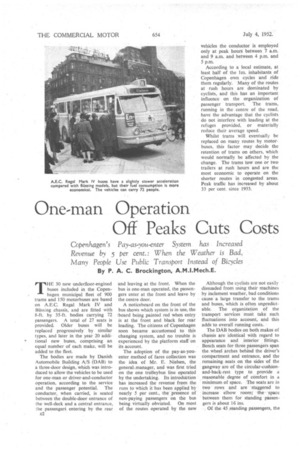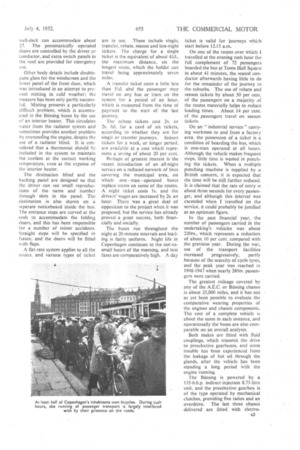One-man Operation Off Peaks Cuts Costs
Page 38

Page 39

Page 40

If you've noticed an error in this article please click here to report it so we can fix it.
Copenhagen's Pay-as-you-enter System has Increased Revenue by 5 per cent.: When the Weather is Bad, Many People Use Public Transport Instead of Bicycles By P. A. C. Brockington, A.M.I.Mech.E.
THE 30 new underfloor-engined buses included in the Copenhagen municipal fleet of 900 trams and 150 motorbuses are based on A.E.C. Regal Mark IV and Bussing chassis, and are fitted with 8-ft. by 35-ft. bodies carrying 72 passengers. A total of 27 seats is provided. Older buses will be replaced progressively by similar types, and later in the year 20 additional new buses, comprising an equal number of each make, will be added to the fleet.
The bodies are made by Danish Automobile Building A/S (DAB) to a three-door design, which was introduced to allow the vehicles to be used for one-man or driver-and-conductor operation, according to the service and the passenger potential. The conductor, when carried, is seated between the double-door entrance of the well-deck and a central entrance, the passenger i entering by the rear c2 and leaving at the front. When the bus is one-man operated, the passengers enter at the front and leave by the centre door.
A noticeboard on the front of the bus shows which system is in use, the I board being painted red when entry is at the front and black for rear loading. The citizens of Copenhagen soon became accustomed to this changing system, and no trouble is experienced by the platform staff on its account.
The adoption of the pay-as-youenter method of fares collection was the idea of Mr. E. Nielsen, the generals manager, and was first tried on the one trolleybus line operated by the undertaking. Its introduction has increased the revenue from the runs to which it has been applied by nearly 5 per cent., the presence of non-paying passengers on the bus being virtually obviated. On most of the routes operated by the new Although the cyclists are not easily dissuaded from using their machines by inclement weather, bad conditions cause a large transfer to the trams and buses, which is often unpredictable. The organization of the transport services must take such fluctuations into account, and this adds to overall running costs.
The DAB bodies on both makes of chassis are identical with regard to appearance and interior fittings. Bench seats for three passengers span the wheel arches behind the driver's compartment and entrance, and the remaining seats on the sides of the gangway are of the circular-cushionand-back-rest type to provide a reasonable degree of comfort in a minimum of space. The seats are in two rows and are staggered to increase elbow room; the space between them for standing passengers is about 16 ins.
Of the 45 standing passengers, the well-deck can accommodate about 27. The pneumatically • operated doors are controlled by the driver or "conductor, and extra switch panels in the roof are provided for emergency use.
Other body details include doublepane glass for the windscreen and the lower panel of the front door, which was introduced in an attempt to prevent misting in cold weather; the measure has been only partly successful. Misting presents a particularly difficult problem, which is accentuated in the Bussing buses by the use of an interior heater. This circulates water from the radiator system and sometimes provides another problem by overcooling the engine, despite the use of a radiator blind. It is considered that a thermostat should be included in the system to maintain the coolant at the correct working temperature, even at the expense of the interior heater.
The destination blind and the backing panel are designed so that the driver can see -small reproductions of the name and number through slots in the panel. The destination is. also shown on a separate .noticeboard inside the bus. The entrance steps are curved at the ends to accommodate the folding doors, 'and this has been responsible for a number of minor accidents. Straight steps will be specified in future, and the doors will be fitted with flaps.
A flat-rate system applies to all the routes, and various types of ticket are in use. These include single, transfer, rebate, season and late-night tickets. The charge for a single ticket is the equivalent of about 4Id., the maximum distance, on the longest route, which the holder can travel being approximately seven miles.
A transfer ticket costs a little less than 51d. ahd the passenger may travel on any bus or tram on the system for a period of an hour. which is measured from the time of payment to the start of the last journey.
The rebate tickets cost 2s. or 2s. 6d. for a card of six tickets, according to whether they are for single or transfer journeys. Season tickets for a week, or longer period, are available at a cost which represents a saving of about 20 per cent.'
Perhaps of greatest interest is the recent introduction of an all-night service on a reduced network of lines covering the municipal area, on which one man operated buses replace trams on some of the routes. A night ticket costs is. and the drivers' wages are increased by 2s. an hour. There was a great deal of opposition to the project when it was proposed, but the service has already proved a great success, both financially and socially.
The buses run throughout the night at 20-minute intervals and loading is fairly uniform. Night life in Copenhagen continues to the not-sosmall hours of the morning, and taxi fares are comparatively high. A day
ticket is valid for journeys which start before 12.15 a.m.
On one of the routes over which I travelled at the evening rush hour the full complement of 72 passengers boarded the bus at Town Hall Square
in about minutes, the seated conductor afterwards having little to do for the remainder of the journey to the suburbs. The use of rebate and season tickets by about 50 per cent. of the passengers on a majority of the routes materially helps to reduce loading times. About 14 per cent. of the passengers travel on season tickets.
On an "industrial service" carrying workmen to and from a facto!), area, the possession of a ticket is a condition of boarding the bus, which is one-man operated at all hours. Although the vehicle makes frequent stops, little time is wasted in punching the tickets. When a multiple punching machine is supplied by a British concern, it is expected that the time will be still further reduced. It is claimed that the rate of entry is about three seconds for every passenger, and although this interval was exceeded when I travelled on the service, it could probably be justified as an optimum figure.
In the past financial year, the number of passengers carried in the undertaking's vehicles was about 220m., which represents a reduction of about 10 per cent. compared with the previous year. During the war, use of the transport facilities
increased progressively, partly . because of the scarcity of cycle tyres, and the peak year was reached in 1946-1947 when nearly 280m. passengers were carried.
The greatest mileage covered by any of the A.E.C. or Bitssing chassis is about 25,000 miles, and it has not as yet been possible to evaluate the comparative wearing properties of the engines and chassis components. The cost of a complete vehicle is about the same in each instance, and operationally the buses are also comparable on an overall analysis.
Both makes are fitted with fluid couplings, which transmit the drive to preselective gearboxes, and some trouble has been experienced from the leakage of hot oil through the glands, after the vehicle has been standing a long period with the engine running.
The Btissing is powered by a 135-b.h.p. indirect-injection 8.73-litre unit, and the preselective gearbox is of the type operated by mechanical clutches, providing five ratios and an overdrive. The last three chassis delivered are fitted with electro magnetic clutches, and the drivers comment favourably on the ease of gear changing. The overdrive has a ratio of 0.65 to 1 and is used only on the longer routes to outlying districts, when a speed of 25 m.p.h. can be continued for some distance. For normal driving, the third, fourth and fifth ratios are employed, the use of the first and second gears being generally unnecessary.
Lower Consumption The 125-b.h.p. engine of the A.E.C. Regal Mark 1V bus gives a slightly reduced acceleration as compared with the Bussing, but its fuel consumption is lower. The average of the Missing is 7.6 m.p.g. and that of the A.E.C. is a little over 8 m.p.g. The three upper ratios of the A.E.C. four-speed gearbox are employed under normal conditions.
Following experience with the Bussing system, ,Copenhagen engineers are not in favour of automatic chassis lubrication, trouble having been experienced with broken pipes
and leaking joints. Woven brake facings are fitted in preference to the moulded type when replacements are made. With the original moulded facings, the Bussing brakes were liable to develop pronounced brake squeal.
Aided by heater plugs, the Bussing engine starts more easily than the A.E.C. unit on cold mornings, and the clutch control, fitted to the radiator fan, is considered to be beneficial
c4
for rapid warming-up and in reducing fuel consumption. Both makes are fitted with radiator blinds under the control of the driver.
The engines of the older types of Leyland and Missing buses in the fleet are completely overhauled by a private concern after the vehicles have covered .62,000 miles without intermediate attention. The power units of the new buses will also be removed for an overhaul at this mileage, if abnormal oil consumption, or reduced performance, indicates the necessity.
Detergent engine oil is employed and changed at 3,000-mile intervals. It is reclaimed for further use in the older vehicles by a specialist concern, the process involving the settlement of impurities after heating to 100 degrees C. Chassis greasing it also performed after 3,000 miles' running, and the injector equipment is tested every 12,500 miles.
The average distance covered by the tyres before retreading is about 50,000 miles. The covers are not regroovecl, but are retreaded twice before being scrapped. In the interests of tyre wear, front-wheel alignment is carefully checked at the same time as the chassis is greased. Worn covers are fitted to the rear wheels in preference to the front.
• All-metal Body
Whilst the bodies built for both makes are identical in form, the body of the Missing is of all-metal construction, whilst that fitted to the A.E.C. has wood frame members. The exterior panels of both buses are screwed to the waistand floor-rails and are lap joined. The vehicles are quiet in operation and the bodies free from drumming and rattles.
Despite the preponderance of trams in the Copenhagen transport system, and their undoubted advantage on certain routes, the success of the maximum-load underfloorengined single-deckers has shown the development of the type to be of outstanding importance in the search for greater economy of operation.
























































































